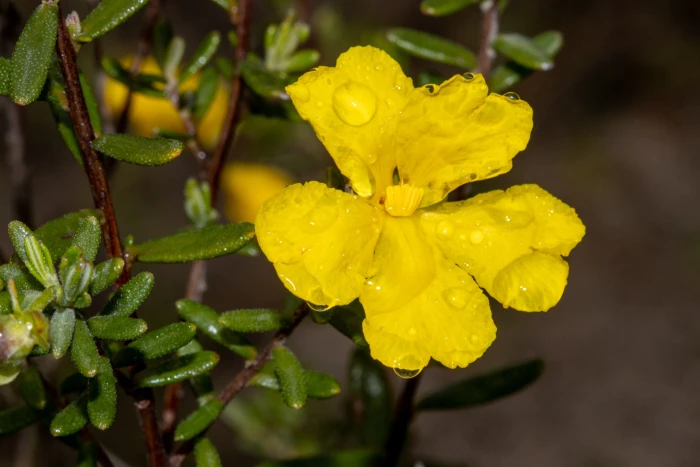Yellow Buttercups
(Hibbertia hypericoides)
Yellow Buttercups (Hibbertia hypericoides)
/
/

Tim Hammer
CC BY 4.0
Image By:
Tim Hammer
Recorded By:
Copyright:
CC BY 4.0
Copyright Notice:
Photo by: Tim Hammer | License Type: CC BY 4.0 | License URL: http://creativecommons.org/licenses/by/4.0/ | Rights Holder: Tim Hammer | Publisher: iNaturalist | Date Created: 2022-09-03T15:35:02-07:00 |

























Estimated Native Range
Climate Requirements for Zhengzhou, China
| This Plant | Your Site | Plant Suitability for Your Location | ||
|---|---|---|---|---|
| • Precipitation | 10" - 90" | 25" | Your precipitation may be insufficient for this plant. Irrigate N" / year. | Irrigate N" / year |
| • High Temp. | 74°F - 102°F | 90°F | Your summer temperatures are normal for this plant. | Excellent |
| • Low Temp. | 33°F - 55°F | 25°F | Your winter temperatures may be too cold for this plant | Too cold |
This plant should grow well at your location with about N inches per year (Y minutes per month) of irrigation.
Summary
Hibbertia hypericoides, commonly known as Yellow Buttercups, St. John’s Guinea Flower, or simply Guinea Flower, is a shrub native to a variety of habitats in Australia, including coastal heathlands, open eucalypt woodlands, and dry sclerophyll forests. It is often found on sandy soils among rocks, which reflects its adaptability to well-drained conditions. This plant typically grows at a moderate rate to a height and width of 1-2 feet (0.3-0.6 meters), forming a dense, bushy habit. The bright yellow, showy flowers resemble buttercups and bloom profusely in the spring and summer, adding a splash of color to the garden.
Hibbertia hypericoides is valued for its vibrant yellow flowers and its ability to thrive in poor soils, making it a popular choice for rockeries, native plant gardens, and as a ground cover. It is also used to stabilize sandy soils and is suitable for coastal gardens due to its tolerance of salt spray. In cultivation, it prefers full sun to part shade and requires well-drained sandy or loamy soils. While it tolerates medium amounts of water, it is relatively drought-tolerant once established. There are no major disease problems associated with this plant, but it may suffer from root rot if overwatered or planted in poorly drained soils. It is not known to be invasive outside its native range.CC BY-SA 4.0
Hibbertia hypericoides is valued for its vibrant yellow flowers and its ability to thrive in poor soils, making it a popular choice for rockeries, native plant gardens, and as a ground cover. It is also used to stabilize sandy soils and is suitable for coastal gardens due to its tolerance of salt spray. In cultivation, it prefers full sun to part shade and requires well-drained sandy or loamy soils. While it tolerates medium amounts of water, it is relatively drought-tolerant once established. There are no major disease problems associated with this plant, but it may suffer from root rot if overwatered or planted in poorly drained soils. It is not known to be invasive outside its native range.CC BY-SA 4.0
Plant Description
- Plant Type: Shrub
- Height: 1-2 feet
- Width: 1-2 feet
- Growth Rate: Moderate
- Flower Color: Yellow
- Flowering Season: Spring, Summer
- Leaf Retention: Evergreen
Growth Requirements
- Sun: Full Sun, Part Shade
- Water: Medium
- Drainage: Medium
Common Uses
Border Plant, Groundcover, Low Maintenance, Rock Garden, Showy Flowers, Street Planting
Natural Habitat
Native to coastal heathlands, open eucalypt woodlands, and dry sclerophyll forests in Australia
Other Names
Common Names: St. John’s Guinea Flower, Guinea Flower
Scientific Names: Hibbertia hypericoides
GBIF Accepted Name: Hibbertia hypericoides